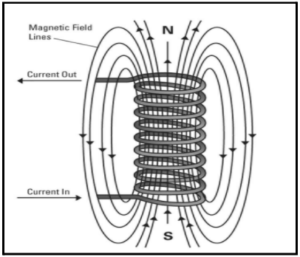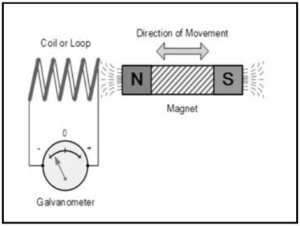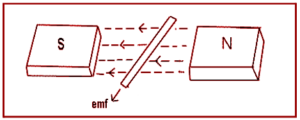Table of Contents
Introduction:
Magnetism has a mystical quality about it. Children are fascinated by its ability to transform metals such as iron, cobalt, and nickel when touched. We may learn about the repulsion and attraction between the magnetic poles by observing the shape of the magnetic field created by the iron filling surrounding the bar magnet.
The forces that govern both magnetism and electricity, according to physicists, are significantly larger than gravity in electromagnetism. The maglev train, which is suspended above its tracks, is a magnificent display of enormous force. Induction is a procedure in which a conductor is positioned in a specified position and the magnetic field varies or remains stationary while the conductor travels.
As an outcome, a voltage or EMF (Electromotive Force) is established across the electrical conductor. The Law of Induction was discovered by Michael Faraday in 1830.
The information about electromagnets and electromagnetic induction from various physics-related articles is available here. Electromagnetic induction and its general concepts are important topics in physics. Students who want to flourish in physics need to be well known about electromagnetic induction to get deep knowledge about it to do well on their exams. The definition, principle, and applications of electromagnetic induction are provided here to assist students in effectively understanding the respective topic. Continue to visit our website for additional physics help.
Overview:
An electromagnet is a magnet that produces its magnetic field using an electric current. Electromagnets are made from wire wound into a coil. A magnetic field is focused in the hole, which serves as the coil’s center, while current flows through the wire.
When the power is switched off, the magnetic field disappears. The wire turns are usually twisted around a magnetic core made of a ferromagnetic or ferrimagnetic material like iron, which concentrates the magnetic flux and makes the magnet stronger. Electromagnets and permanent magnets are not the same things. Electromagnets are built up of electrically conducting wire coils.
Because moving charges produce magnetic fields, an electromagnet’s coils behave like magnets when an electric current flows through them. The coils stop working as magnets when the power is switched off. Electromagnets are used in a number of electrical devices when magnetic forces are only needed for a short duration.

In general, ‘Electromagnetic Induction’ is the induction of an electromotive force by the motion of a conductor across a magnetic field or by a change in magnetic flux in a magnetic field. It is a non-contact mechanism in which a changing magnetic flux (i.e., changing number of magnetic field lines) is caused by a second circuit placed in the magnetic field. Current flows in the second circuit as a result of this change.
The most prevalent method of generating electricity is electromagnetic induction, which is based on the rotation of a magnet around a stationary conductor. A magnetic induction current is the induced electric current that occurs when an alternating electric field is applied to a conductor carrying an electric current.

When a conductor is set in a moving magnetic field (using an AC power source), or when a conductor is always moving in a stationary magnetic field, this occurs.
Michael Faraday discovered this electromagnetic induction law. He set up a leading wire, which he connected to a device that measured the voltage across the circuit.
When a bar magnet passes through the device, the voltage in the circuit is monitored. The significance of this is that it is a method of producing electrical energy in a circuit by employing magnetic fields rather than batteries.
Principle of Electromagnetic Induction:
The emf induced in a loop by a changing magnetic flux is equal to the rate of change of the magnetic flux threading the loop, according to the Principle of Electromagnetic Induction. Generators, transformers, and motors all operate on the principle of electromagnetic induction.
The equation that mathematically describes electromagnetic induction is known as Faraday’s Law. It states that when the magnetic environment of a coiled wire change, voltage (EMF) would be induced. Faraday identified a number of ways for this to occur. For example, by moving a magnet over a coil of wire or moving a coil of wire through a magnetic field, you can change the magnetic field strength. The following equation can be used to explain the voltage (EMF) generated:
EMF=-N Δ(BA)/t
Here, N is considered as the number of turns in the wire.
Δ(BA) is said to be the difference in magnetic flux.
t is called the difference in time.

Applications of Electromagnetic Induction:
Electromagnetic induction is a very useful phenomenon that may be used in a wide range of situations. It’s worth looking into how induction works in power generation and transmission. Other phenomena to consider include eddy currents, which have some fascinating uses.
- Eddy currents: An eddy current is a whirling current that forms in a conductor when the magnetic field changes. According to Lenz’s law, the current swirls in such a way that it creates a magnetic field that opposes the change; in a conductor, electrons swirl in a plane perpendicular to the magnetic field to accomplish this. Eddy currents waste energy because they tend to oppose each other.
- Eddy currents, more precisely, convert more useful forms of energy, such as kinetic energy, into heat, which is generally less useful. Although the loss of usable energy is undesirable in many applications, it does have some beneficial applications. Some trains have one in the brakes.
- The metal wheels are subjected to a magnetic field from an electromagnet while braking, which generates eddy currents in the wheels.
- The magnetic contact between the applied field and the eddy currents slows the wheels. The impact is larger the quicker the wheels spin, thus as the train slows down, the braking force is reduced, resulting in a smooth stop.
- An electric generator: An electric motor turns electrical energy into mechanical energy; an electric generator does the opposite, generating electricity from mechanical energy. A wire coil in a magnetic field is at the heart of both motors and generators.
- In reality, the device can function as both a motor and a generator. A current is passed via the coil when the gadget is employed as a motor. The coil spins due to the interaction of the magnetic field with the current. The coil can be spun to induce a current in the coil, allowing the device to be used as a generator.
- Transformers: Electricity is frequently generated far from where it is consumed and transferred across large distances via power lines. Although the resistance of a small length of the power line is generally low, the resistance can become significant over a long distance.
- There is a very simple way to increase voltage and decrease current (or vice versa) using AC power and Faraday’s law of induction, and that is to use a transformer. A transformer is made up of two coils, each with a different number of loops, that are connected by an iron core and allow magnetic flux from one coil to pass through to the other.
- When the flux generated by one coil changes (which it does constantly if the coil is connected to an AC power supply), the flux flowing through the other coil changes as well, causing a voltage to be inducted into the second coil. The voltage induced in the second coil will be AC if the power source is AC.
Also read: Electromagnetic Radiation
Frequently Asked Question (FAQs):
Question 1: What is meant by Electromagnetic Induction?
Answer: In general, ‘Electromagnetic Induction’ is the induction of an electromotive force by the motion of a conductor across a magnetic field or by a change in magnetic flux in a magnetic field. It is a non-contact mechanism in which a changing magnetic flux (i.e., changing number of magnetic field lines) is caused by a second circuit placed in the magnetic field.
Question 2: What are the uses of Electromagnetic Induction?
Answer: Washing machines, railways, electric hobs, cookers, welding, guitar pickups, and transformers are examples of equipment that utilize electromagnetic induction with the help of electric motors.
Question 3: What is Electromagnet?
Answer: An electromagnet is a magnet that develops its magnetic field using an electric current. Electromagnets are made from wire wound into a coil. A magnetic field is focused in the hole, which serves as the coil’s center, while current flows through the wire.





